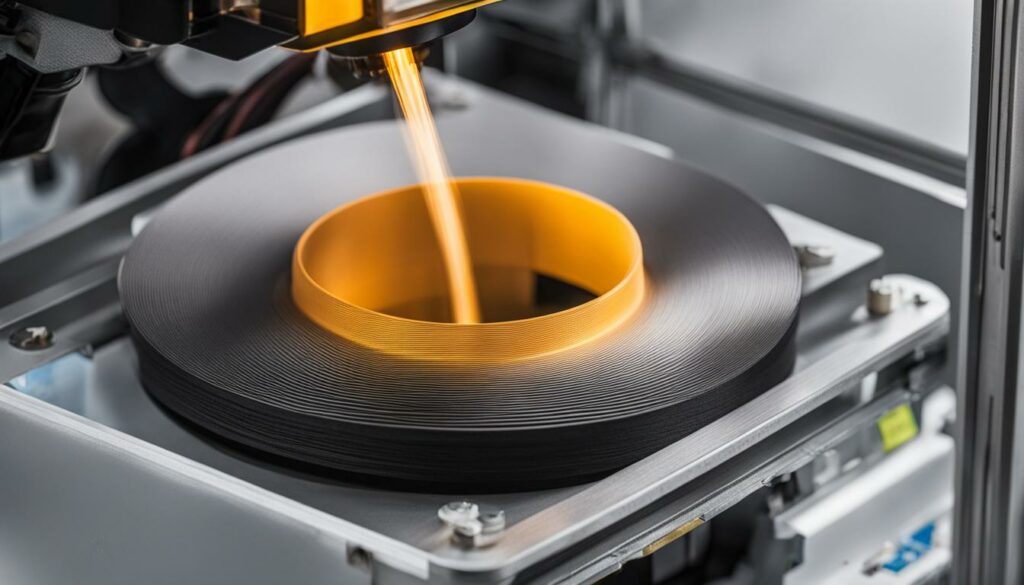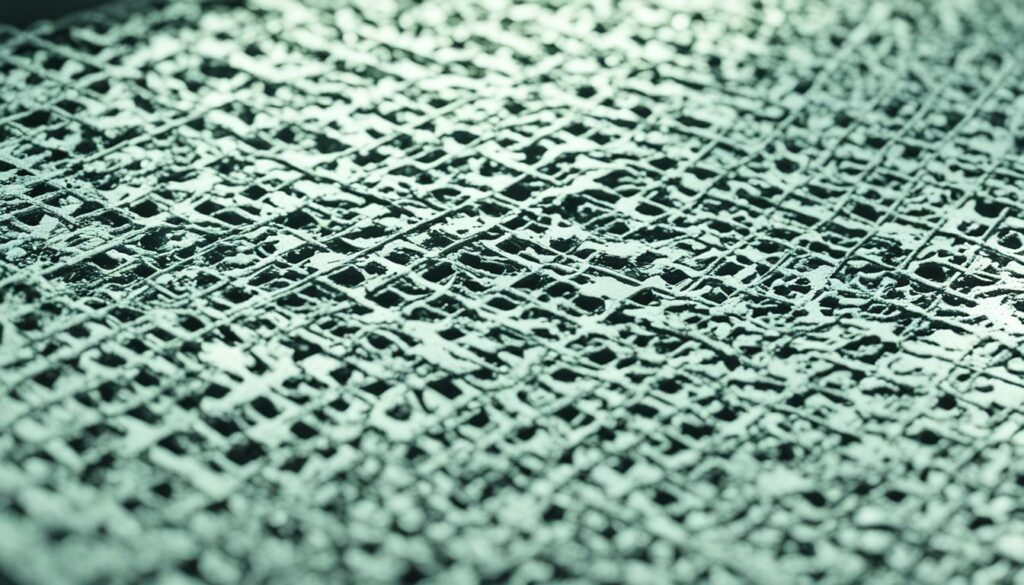When it comes to printers, the print head plays a crucial role in ensuring clear and accurate prints. But have you ever wondered how long a print head actually lasts? The lifespan of a print head can vary depending on various factors, and understanding these factors is essential for maximizing its durability and performance.
In this article, we will explore the longevity of print heads and the key factors that can impact their lifespan. We will also provide valuable tips on maintenance, proper handling, and choosing the right media for optimal print head performance.
Key Takeaways:
- The lifespan of a print head can be influenced by factors such as the quality of labels and print ribbon, maintenance practices, and environmental conditions.
- Regular cleaning of the print head is essential to prevent any buildup and ensure longevity.
- Choosing the right media, including labels and print ribbons, can significantly impact the print head's lifespan.
- Proper maintenance, including purging the print head and using high-quality filament, is crucial for extending its longevity.
- Handle the print head with care, avoiding any attempts to remove or clean the nozzles with abrasive materials.
Factors Affecting Print Head Lifespan
Several factors can significantly impact the lifespan of a print head. By understanding and addressing these factors, you can optimize the durability and performance of your print head.
Quality of Labels and Print Ribbon
The quality of labels and print ribbon used in the printing process plays a crucial role in the lifespan of the print head. Inferior quality labels or print ribbon can cause excessive wear and tear on the print head, leading to premature failure. It is essential to invest in high-quality labels and print ribbon that are compatible with your printer model.
Proper Maintenance and Cleaning
Regular maintenance and cleaning are vital to extend the lifespan of the print head. Accumulation of debris, dust, or dried ink can negatively impact its performance. Follow the manufacturer's guidelines for cleaning and maintenance, including periodic cleaning and nozzle checks. It is advisable to use approved cleaning agents and lint-free cloths to prevent damage to the print head.
Choosing the Right Media
The type and quality of media used in conjunction with the print head can affect its longevity. Ensure that the media, such as labels or paper, is compatible with your printer's specifications. Using inappropriate media can cause excessive friction or damage to the print head, reducing its lifespan.
Printer Maintenance
Maintaining the overall health of the printer is crucial for preserving the print head's lifespan. Regularly perform printer maintenance tasks such as replacing worn-out parts, lubricating moving components, and monitoring printer settings. Following the manufacturer's recommended maintenance schedule can help prevent potential issues that could impact the print head.
Environmental Conditions
The environment in which the printer operates can have a significant impact on the print head's lifespan. Exposure to extreme temperatures, humidity, or dust can cause damage over time. Ensure that the printer is located in an optimal environment with controlled temperature and humidity levels. If necessary, consider using protective casings for additional safeguarding.
By considering these factors and implementing appropriate measures, you can maximize the lifespan of your print head, reducing costs and ensuring consistent print quality.

Printhead Cleaning
Regular cleaning of the print head is crucial for maintaining its longevity and optimal performance. By keeping the print head clean, you can prevent clogs, streaks, and other printing issues that may arise from debris or residue buildup.
For thermal transfer printers, it is recommended to clean the print head and platen roller every time you change the print ribbon. This ensures that any residual ink or adhesive from the previous ribbon does not interfere with the new print job. Similarly, for direct thermal printing, it is advisable to clean the print head after each media change to avoid any contamination.
When cleaning the print head, it is essential to use appropriate cleaning agents or lint-free cleaning cloth soaked in isopropyl alcohol. This helps to effectively remove ink, dust, or other contaminants without damaging the print head. Avoid using abrasive materials or rough cloths that can scratch or compromise the integrity of the print head surface.
One important tip to remember is to avoid touching the print head with bare hands. The natural oil and dirt on your hands can transfer onto the print head and cause contamination. Always wear gloves or use clean lint-free cloth when handling the print head to maintain its cleanliness.
Regular printhead cleaning not only prolongs the lifespan of the print head but also ensures consistent and high-quality prints. By incorporating this simple maintenance routine into your printing workflow, you can minimize downtime, reduce the need for printhead replacements, and achieve optimal printing performance.

| Cleaning Agent | Effectiveness | Gentle on Print Head | Ease of Use |
|---|---|---|---|
| Isopropyl Alcohol | High | Yes | Easy |
| Cleaning Solutions | Varies | Depends on the formula | Requires proper dilution and precautions |
| Lint-free Cloth | Medium | Yes | Easy |
Choosing the Right Media
When it comes to maximizing the lifespan of your print head, selecting the right media is crucial. The type and quality of labels, print ribbon, and media used can have a significant impact on print head quality and longevity. By choosing good quality products and aligning them with your printer's specifications, you can ensure optimal performance and protect your print head from potential damage.
The Importance of Label Quality
For direct thermal printing, paying special attention to the quality of labels is essential. High-quality labels can prevent residue buildup and reduce the risk of adhesive residue or debris harming the print head. Look for labels that are specifically designed for thermal printing to ensure compatibility and longevity.
Optimizing Print Ribbon Quality
For thermal transfer printing, using a good quality print ribbon is crucial. A high-quality print ribbon can help prevent smudging, ensure clear and sharp prints, and reduce the likelihood of ribbon residue accumulating on the print head. Make sure to choose a print ribbon that is compatible with both your printer and the labels you are using.

Alignment Matters
In the thermal transfer method, it is important to ensure proper alignment between the labels and the print ribbon. Misalignment can cause unnecessary friction, leading to premature wear and tear on the print head. Always double-check the alignment before initiating each print job to minimize the risk of damage and maximize print head lifespan.
“Choosing the right media is crucial for preserving the quality and lifespan of your print head. High-quality labels, compatible print ribbons, and proper alignment are key factors to consider. Investing in the right media not only protects your print head, but also ensures clear, vibrant prints.”
| Media Type | Characteristics |
|---|---|
| Direct Thermal Labels | Designed specifically for direct thermal printing Prevent adhesive residue and debris buildup Ensure compatibility with thermal printers |
| Thermal Transfer Print Ribbons | Good quality to prevent smudging and residue Compatible with printer and labels Proper alignment with labels |
Printer Maintenance
Proper maintenance plays a crucial role in ensuring the longevity of your printer and the print head. By following essential maintenance practices, you can maximize the performance of your printer and avoid potential issues that may arise due to neglect.
Maintaining the printer involves various tasks that should be performed regularly. One of the key aspects of printer maintenance is using only original parts for repairs and replacements. Using third-party or counterfeit parts can compromise the functionality of the printer and lead to potential damage to the print head.
Regular cleaning of the printer, including the print head and platen roller, is also essential. Dust, debris, and paper residue can accumulate over time, affecting the print quality and potentially damaging the print head. By cleaning the printer regularly with the appropriate cleaning agents, you can prevent build-up and ensure proper functioning of the print head.
Additionally, inspecting the printer for any signs of wear and tear, such as loose connections or damaged components, is important. Addressing these issues promptly can prevent further damage and ensure the printer operates smoothly.
Proper adjustment of the printer is crucial to maintain optimal print quality and prevent unnecessary stress on the print head. Adjusting the print head pressure and ensuring proper alignment of the media can help prevent issues such as print smudging or poor print quality.
To summarize, adhering to a regular maintenance routine and using genuine parts are key to maintaining the printer and extending the lifespan of the print head. By doing so, you can ensure consistent print quality and avoid costly repairs.
Environmental Conditions
Environmental conditions play a significant role in the lifespan of a print head. Exposure to water and extreme temperatures can have detrimental effects on its performance and durability. It is vital to adhere to the printer's specifications and take necessary precautions to protect the print head.
One way to safeguard the print head from environmental factors is by considering the use of a protective casing. This additional layer of protection can shield the print head from potential water damage and help regulate temperature fluctuations that could otherwise impact its longevity.
Furthermore, proper storage of labels and print ribbons is crucial. Storing these consumables in a dry and controlled environment prevents damage to the print head and avoids the accumulation of unwanted residue that could affect the printing quality.

Warranty and Typical Lifespan
When it comes to print head lifespan, it's important to consider the warranty period and the typical longevity of these essential components. In general, print heads come with a standard warranty of 100 days from the date of purchase or 500 print hours, whichever comes first. This warranty ensures that any unexpected issues or defects during the initial period are covered and can be addressed accordingly.
However, with proper care, maintenance, and adherence to best practices, print heads can actually last much longer than the warranty period. In fact, it's not uncommon for a print head to endure up to 2000 print hours with the right precautions in place.
Regular Maintenance for Prolonged Lifespan
To maximize the lifespan of a print head, regular maintenance is essential. Here are some key maintenance practices that can extend the longevity of your print head:
- Purging the Print Head: Regularly purging the print head, typically every 10-15 print hours, helps ensure optimal performance and prevents clogs or blockages that can reduce its lifespan.
- Keeping the Filament Dry and Clean: Moisture or foreign particles in the filament can be detrimental to the print head. Therefore, it's important to store the filament properly in a dry environment and avoid exposing it to humidity or contaminants.
- Using High-Quality Filament: Opting for high-quality filament not only improves print quality but also reduces the risk of nozzle damage or clogs that can impact the print head's lifespan.
- Avoiding Nozzle Damage: Careful handling is crucial to prevent any accidental damage to the print head's delicate nozzles. Avoid touching the nozzles or using abrasive materials that could cause harm.
By following these maintenance tips, you can significantly prolong the lifespan of your print head and ensure trouble-free printing for an extended period.
| Print Head Warranty | Typical Lifespan with Proper Care |
|---|---|
| 100 days or 500 print hours | Up to 2000 print hours |
As shown in the table, while the standard warranty offers coverage for a limited period, implementing regular maintenance practices and utilizing high-quality materials can greatly increase the typical lifespan of a print head.
Regular Maintenance
Regular maintenance is essential to ensure the longevity of both your printer and print head. By implementing a proactive maintenance routine, you can optimize the performance and extend the lifespan of your equipment.
Purging the print head: It is recommended to purge the print head every 10-15 print hours for optimal performance. This process helps remove any accumulated debris or dried ink that may affect the print quality or clog the nozzles. The frequency of purging may vary depending on the type of material being used and the manufacturer's guidelines.
Keeping the filament dry and clean: Proper storage of the filament is crucial to prevent moisture absorption, which can lead to print head clogs and decreased print quality. Ensure that you store the filament in a dry environment and protect it from dust and contaminants. Additionally, periodically inspect the filament for any signs of damage or degradation.
Using high-quality filament: The quality of the filament you use directly impacts the performance and durability of your print head. Opt for high-quality filaments from reputable manufacturers that meet the specifications of your printer. Using subpar or incompatible filaments may cause blockages, nozzle damage, or inconsistent printing results.
Important: Always follow the manufacturer's recommendations for print head maintenance and refer to the specific instructions provided with your printer.
To summarize, regular maintenance, including purging the print head, keeping the filament dry and clean, and using high-quality filament, is vital for optimal printer performance and to maximize the longevity of your print head.

Printer Maintenance Checklist
| Task | Frequency |
|---|---|
| Clean print head and platen roller | After each print ribbon change |
| Purge print head | Every 10-15 print hours |
| Inspect filament for damage | Regularly, before each use |
| Store filament in a dry environment | At all times |
| Use high-quality filament | Always |
Proper Handling and Care
Proper handling and care of the print head are crucial for maintaining its longevity and optimal performance. Taking the necessary precautions can help prevent damage and prolong the lifespan of your print head. Here are some essential tips:
Avoid Attempting to Remove the Nozzles
One common mistake is attempting to remove the nozzles of the print head. It's important to remember that the print head is a delicate component that requires specialized knowledge and tools for proper maintenance. Trying to remove the nozzles yourself can lead to irreparable damage, affecting the print head's performance.
Use Gentle Cleaning Methods
When cleaning your print head, it's crucial to use gentle methods and avoid abrasive materials. Abrasive cleaning agents or rough cleaning cloths can scratch the surface of the print head, causing damage to the nozzles and affecting the print quality. Instead, use lint-free cleaning cloths soaked in isopropyl alcohol to remove any debris or residue.
“Proper handling and care of the print head are crucial for maintaining its longevity and optimal performance.”
Handle the Print Head with Clean Hands
When handling the print head, ensure that your hands are clean and free from oils or contaminants. Touching the print head with bare hands can transfer oils and dirt, which may impact the performance of the nozzles. If necessary, use gloves or a clean cloth to handle the print head to minimize the risk of contamination.
Protect the Print Head from Physical Damage
To avoid physical damage to the print head, it's important to be mindful of its placement and surroundings. Keep the printer in a secure location where it is less likely to be bumped or knocked over. Additionally, avoid placing any objects on top of the printer that may cause pressure or impact on the print head.
By following these proper handling and care practices, you can ensure the longevity and optimal performance of your print head, ultimately extending its lifespan and reducing the need for repairs or replacements.

Summary:
- Avoid attempting to remove the nozzles of the print head.
- Use gentle cleaning methods and avoid abrasive materials.
- Handle the print head with clean hands to prevent contamination.
- Protect the print head from physical damage by ensuring its proper placement.
Factory Defect and Warranty Coverage
Although uncommon, there is always a slight possibility of a factory defect affecting your print head. In such cases, it is crucial to understand your warranty coverage to ensure a swift resolution. If a failure occurs that falls within the warranty terms, the print head can be repaired or replaced, provided you have the necessary documentation such as proof of purchase and details of the failure.
It is recommended that you familiarize yourself with the warranty terms and conditions provided by the manufacturer. This will help you understand the specific coverage for print head issues and the steps to follow for warranty claims. Keep in mind that warranty coverage may vary between manufacturers and models, so it's essential to consult the official documentation or contact customer support for accurate information.

Importance of Quality and Original Spare Parts
When it comes to the longevity and performance of your print head, the quality of the components you use is of utmost importance. Choosing high-quality labels, print ribbons, and other printer parts can significantly impact the lifespan and functionality of your print head.
Using good quality products ensures that the print head operates smoothly, delivering accurate and crisp prints consistently. Original spare parts, specifically designed for your printer model, are engineered to meet the highest standards of quality and compatibility. These parts offer superior performance and durability, reducing the risk of downtime and maintenance issues.
By investing in original spare parts, you can reap the following benefits:
- Optimal performance: Original spare parts are designed to seamlessly integrate with your printer, ensuring optimal performance and reliability. They undergo rigorous testing to meet strict quality standards, providing consistent and high-quality prints.
- Enhanced durability: Original spare parts are built to last, with durable materials and precision engineering. They are specifically designed to withstand the demands of continuous printing, minimizing the risk of premature wear and tear.
- Compatibility: Original spare parts are guaranteed to be compatible with your printer model, eliminating compatibility issues that may arise from using generic or counterfeit parts. This compatibility ensures seamless installation and operation of the spare parts.
- Warranty coverage: Using original spare parts often comes with warranty coverage, providing you with peace of mind and protection against manufacturing defects or malfunctions. With warranty coverage, you can have confidence in the performance and reliability of your print head.
Remember, using subpar or counterfeit components may save you money initially, but it can have detrimental effects on your print head's longevity and overall performance. Don't compromise on quality when it comes to the key components of your printer system.
Invest in original spare parts, sourced from reputable suppliers, to ensure the longevity and optimal performance of your print head. Choose quality over cost to protect your investment and enjoy consistent, high-quality prints every time.
| Benefits of Using Quality and Original Spare Parts |
|---|
| Optimal Performance |
| Enhanced Durability |
| Compatibility |
| Warranty Coverage |
Conclusion
Maximizing the lifespan of your print head is crucial for maintaining its durability and maximizing its performance. By carefully considering factors such as proper maintenance, appropriate media selection, and careful handling, you can ensure that your print head serves you well over time.
Start by regularly cleaning your print head using the recommended cleaning agents or lint-free cloth soaked in isopropyl alcohol. Avoid touching the print head with bare hands, as oils and contaminants can reduce its lifespan. Additionally, choose high-quality labels, print ribbons, and media that are specifically designed for your printer's specifications.
Proper printer maintenance and adjustment are also essential. Use genuine spare parts for maintenance to ensure proper functionality. Pay attention to environmental conditions, such as exposure to water and extreme temperatures, as they can have adverse effects on the print head. Consider protective casings and appropriate storage for labels and print ribbons to prevent damage.
Remember, print heads typically come with a warranty, but with proper care and maintenance, they can last even beyond the warranty period. By following these guidelines and investing in the longevity of your print head, you can ensure reliable and high-quality printing for all your business needs.

I'm Morgan, the creator of VPNForMe — a site born from too many hours spent side-eyeing sketchy VPN reviews and buffering videos.
I wanted a place where people could get straight answers about privacy, streaming access, and which VPNs actually deliver — without the hype or tech jargon.

